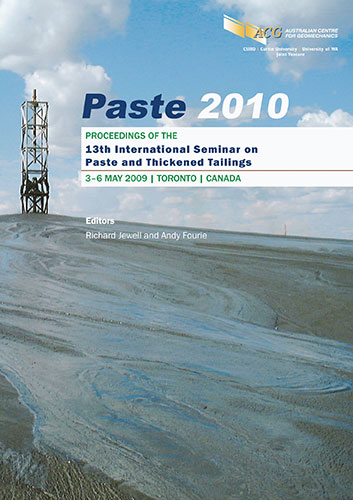Monitoring barricade performance in a cemented paste backfill operation

|
Authors: Thompson, BD; Bawden, WF; Grabinsky, MW; Karaoglu, K |
DOI https://doi.org/10.36487/ACG_rep/1063_16_Thompson
Cite As:
Thompson, BD, Bawden, WF, Grabinsky, MW & Karaoglu, K 2010, 'Monitoring barricade performance in a cemented paste backfill operation', in R Jewell & AB Fourie (eds), Paste 2010: Proceedings of the Thirteenth International Seminar on Paste and Thickened Tailings, Australian Centre for Geomechanics, Perth, pp. 185-197, https://doi.org/10.36487/ACG_rep/1063_16_Thompson
Abstract:
Efficient barricade design and construction practices can have an important impact on mining cycle time and therefore on the economic performance of the mining operation as a whole. However, standardised procedures have yet to be developed that will allow the mining engineer to reasonably predict barricade performance and assess the actual behaviour of the barricade during filling, curing, and subsequent mining of surrounding stopes. A case study will be presented in which a reinforced shotcrete barricade is instrumented to measure pressures exerted on the barricade and its corresponding deformation. Various points within the fill mass are also instrumented to measure total and effective stresses and to assess hydration progress in situ. The study provides important insights regarding the mechanisms of backfill curing and the establishment of an initial stress state within the fill mass and on the barricade. General recommendations are developed so that other mine sites may follow similar procedures to optimise their barricade design and construction practices.
References:
Grabinsky, M.W. (2010) In situ monitoring for ground truthing paste backfill designs, in Proceedings 13th International
Seminar on Paste and Thickened Tailings, Australian Centre for Geomechanics, Perth, Australia.
Grabinsky, M.W. and Thompson, B.D. (2009) Thermally induced stresses in cemented paste backfill, Geotechnical
News, Vol. 27(3), pp. 36–40.
Grabinsky, M.W., Bawden, W.F. and Thompson, B. (2008) Back-analysis of barricade performance for a paste filled
stope. Symposium on Mines and the Environment 2008, Rouyn-Noranda, pp. 162–174.
Grabinsky, M.W. and Simms, P. (2006) Self-desiccation of cemented paste backfill and implications for mine design, in
Proceedings Ninth International Seminar on Paste and Thickened Tailings, Australian Centre for Geomechanics,
Perth, Australia, pp. 323–332.
Helinski, M., Fourie, A.B., Fahey, M. and Ismail, M. (2007) Assessment of the self-desiccation process in cemented
mine backfills, Canadian Geotechnical Journal, Vol. 44, pp. 1148–1156.
Li, L. and Aubertin, M. (2009) Influence of water pressure on the stress state in stopes with cohesionless backfill,
Geotechnical and Geological Engineering, Vol. 27, pp. 1–11.
Mitchell, R.J., Olsen, R.S. and Smith, J.D. (1982) Model studies on cemented tailings used in mine backfill, Canadian
Geotechnical Journal, Vol. 19(3), pp. 289–295.
Mitchell, R.J. (1992) Centrifuge model studies of fill pressures on temporary bulkheads, Canadian Institute of Mining
Bulletin, Vol. 85(960), pp. 48–54.
Simms, P. and Grabinsky, M.W. (2009) Direct measurement of matric suction in triaxial tests on early age cemented
paste backfill, Canadian Geotechnical Journal, Vol. 46, pp. 93–101.
Simon, D., Grabinsky, M.W. and Thompson, B.D. (2010) A study of the effect of paste composition on the water
content of cemented paste backfill using non-destructive electromagnetic wave based techniques, Canadian
Geotechnical Journal, submitted.
Thompson, B.D., Grabinsky, M.W., Counter, D.B. and Bawden, W.F. (2009) In situ measurements of Cemented Paste
Backfill in Long-hole stopes, In Proceedings Canadian Rock Mechanics Symposium.
Yumlu, M. and Guresci, M. (2007) Paste Backfill Bulkhead Monitoring – A Case Study from Inmet’s Cayeli Mine,
Turkey, In Proceedings Minefill 2007 Conference, paper no. 2479.
Monitoring barricade performance in a cemented paste backfill operation B.D. Thompson et al.
198 Paste 2010, Toronto, Canada
© Copyright 2025, Australian Centre for Geomechanics (ACG), The University of Western Australia. All rights reserved.
View copyright/legal information
Please direct any queries or error reports to repository-acg@uwa.edu.au
View copyright/legal information
Please direct any queries or error reports to repository-acg@uwa.edu.au